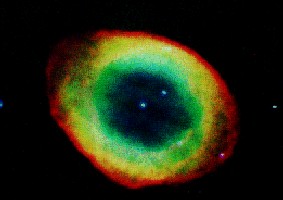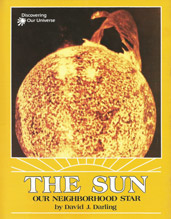THE SUN: Our Neighborhood Star - 4. The Birth and Death of the Sun

Figure 1. In its old age, the Sun may shed a colorful nebula like this one.
It's hard to imagine that the Sun has not always been the way it is today. Yet there was time, in the distant past, when the Sun did not exist.
More than 5 billion years ago, there was no Sun, no Earth, no solar system at all. There was, instead, just a huge, thin cloud of gas and dust slowly turning and drifting through space.
Gradually, the cloud became smaller. Because of its own gravity it pulled itself together. At the same time, it began to get hotter and denser.
By about 5 billion years ago, nearly all the cloud's gas was packed into a big, fuzzy ball at the center of the cloud. Then a very important thing happened. Deep inside the ball, the temperature rose high enough for fusion to start. Hydrogen began to turn into helium, making light and heat. What had been a ball of gas became a star: the Sun.
But there was more to come. Not all of the gas had been used up in making the Sun. Some of it settled into a flat, pancake-shaped cloud that now circled the newborn star. Slowly, from this cloud, the planets, moons and other members of the Sun's family formed.
What will happen to the Sun in the future? For billions of years, it will carry on "burning" hydrogen fuel in its core. Although the Sun uses up around 5 million tons of hydrogen every second, it still has enough left i its core to last for another 5 billion years or so.
When it finally does run out of fuel, though, something very odd will happen to the Sun. It will swell up to many times its present size and become what is known as a red giant.
The outer layers of the Sun will grow to swallow up, in turn, the planets Mercury and Venus. They may even reach out as far as Earth. Then, the surface of our planet will be scorched, and its oceans boiled dry.
As a red giant, the Sun might be able to exist for a few more million years. During this time it will shed matter quite quickly. The solar wind will strengthen to a solar gale. Finally, the Sun may cast off most of its outer layers as a bright shell of gas called a planetary nebula (see Figure 1).
All that will be left behind is a very hot, dense core. The Sun, in fact, will have become a white dwarf - a star no bigger than the Earth. Gradually, over many millions of years, even this small star will cool. The Sun will end its days quietly as a dimming ember in space.
Before this happens, human beings may have learned how to travel to other stars. We may be able to make our home on a planet around a friendlier star. But perhaps we will leave behind a robot probe to watch the final fate of our old neighborhood star.

